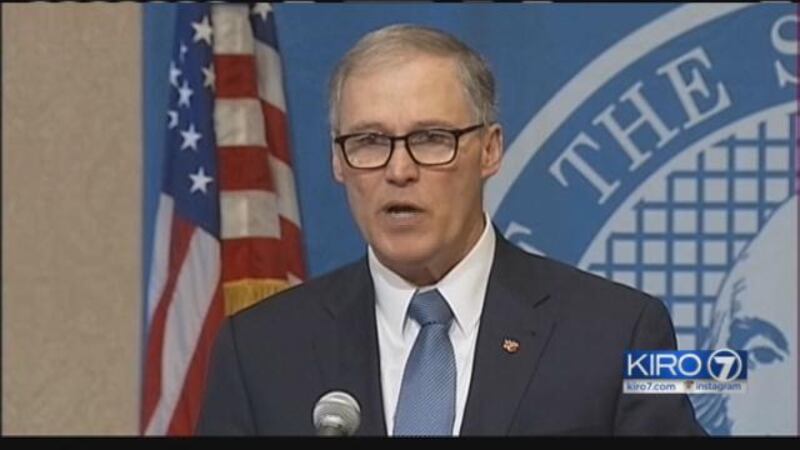OLYMPIA, Wash. — Governor Jay Inslee took the extraordinary step Thursday of ordering a temporary halt to drilling the State Route 99 tunnel after a sinkhole formed behind the troubled machine Bertha.
"I have great concerns about public safety if the contractor were to move forward without addressing the root causes of this sinkhole," Inslee said at an Olympia news conference.
Inslee said tunneling will not continue until contractors satisfy state experts that it won't happen again.
Key Developments:
- A sinkhole formed on the State Route 99 tunnel project Tuesday night in ground that the drill Bertha mined through last week.
- The sinkhole formed as Seattle Tunnel Partners – the contractor – was dealing with a problem with hauling away excavated soil on barges.
- Bertha had mined more than 190 feet and installed 30 concrete tunnel rings since first moving forward in the access pit on Dec. 22.
- Bertha is digging a tunnel to eventually replace the Alaskan Way Viaduct. The project has been delayed several times over the last few years.
Inslee said he is concerned about another sinkhole developing as the machine tunnels beneath the earthquake-vulnerable Alaskan Way Viaduct, which the tunnel is replacing.
“We need to be assured this is not going to happen underneath the viaduct with obvious ramifications that would be very, very concerning or under the City of Seattle," Inslee said.
Where is the sinkhole?
A sinkhole formed on the State Route 99 tunnel project Tuesday night in ground that the drill Bertha mined through last week.
Chris Dixon of Seattle Tunnel Partners said the hole measured 35 feet long, 20 feet wide and 15 feet deep.
It was filled with 250 cubic yards of concrete.
"The sinkhole's an unfortunate event but it wasn't unique or something that wasn't anticipated," Dixon said on Wednesday.
Sinkholes can happen on tunnel projects, especially in soft soil, which is why contractors installed a concrete wall beside the Alaskan Way Viaduct to protect it.
Dixon said the viaduct was not affected by the sinkhole, nor was anything else damaged. Click here to see KIRO 7 News' interview with Dixon.
WSDOT officials clarified that the settlement mentioned in the letter refers to "the path where the machine has mined since it restarted."
When did the sinkhole develop?
The sinkhole formed as STP was dealing with a problem with hauling away excavated soil on barges.
On Tuesday morning, a barge being loaded with material listed to one side and struck some concrete fenders.
Some clean soil spilled into Elliott Bay, and both the fenders and the barge were damaged.
Dixon said STP is bringing in a new type of fender to resume barge operations and is also working on a parallel effort to clear off an area of a pier to hold excavated material. He expected a solution to be in place in a few days so Bertha can resume tunneling.
Mining temporarily stopped after the barge incident because there was nowhere to put the dirt.
What did WSDOT say about Bertha?
In a letter Thursday to contractor Seattle Tunnel Partners, Brian Nielsen, Deputy Program Administrator for the Washington State Department of Transportation, wrote: "The full extent of ground loss is not yet determined and settlement is increasing."
WSDOT officials clarified that the settlement mentioned in the letter refers to "the path where the machine has mined since it restarted."
On Wednesday, contractors downplayed the sinkhole's significance.
Even Nielsen, of WSDOT, sounded reassuring in his comments with reporters.
"The public should not be worried about the safety of themselves or the viaduct when we mine underneath the viaduct," Nielsen told KIRO 7.
Nielsen also said Wednesday "we believe that there's appropriate protocols in place to minimize any chance of a void like this occurring (in the future)."
>> Find a Q&A about Bertha here.
Before Bertha broke down in December 2013, contractors double-checked the amount of excavated dirt every six-and-a-half feet because too much dirt could signal a gap underground where a sinkhole might form.
Then, that potentially vulnerable area of soil was strengthened with grout.
Contractors Wednesday acknowledged they did not follow that protocol last week as Bertha broke out of the repair pit.
During a news conference, KIRO 7 asked Dixon if that was an oversight.
"Some might consider it, but there's a lot of things we look at with the TBM operation, there's a lot of things we look at with the TBM performance data," Dixon replied.
Dixon said on Wednesday that contractors were monitoring ground movement in other ways, but acknowledged they were more focused on how the machine was performing after repairs.
Inslee sounded baffled by the protocol switch.
"They did that for some period of time and then they stopped when they restarted tunneling. Frankly I don't understand that decision at all," Inslee said.
Dixon did not return a phone call on Thursday.
How long will the review take?
It is unclear how long the review of the sinkhole will take and when drilling might resume.
On Wednesday, Dixon suggested a possibility of what caused the sinkhole: "In periods where we were not advancing the TBM we were rotating the cutterhead, which may have contributed to loosening some of the soils, creating some of the volume loss that resulted in the sinkhole.
What does this mean for the Bertha project?
As of Tuesday morning, state officials said Bertha had mined more than 190 feet and installed 30 concrete tunnel rings since first moving forward in the access pit on Dec. 22.
The machine's cutting teeth struck a 119-foot pipe, eight inches in diameter, on December 3, 2013, bringing it to a stop
Want to talk about the news of the day? Watch free streaming video on the KIRO 7 mobile app and iPad app, and join us here on Facebook.
KIRO








